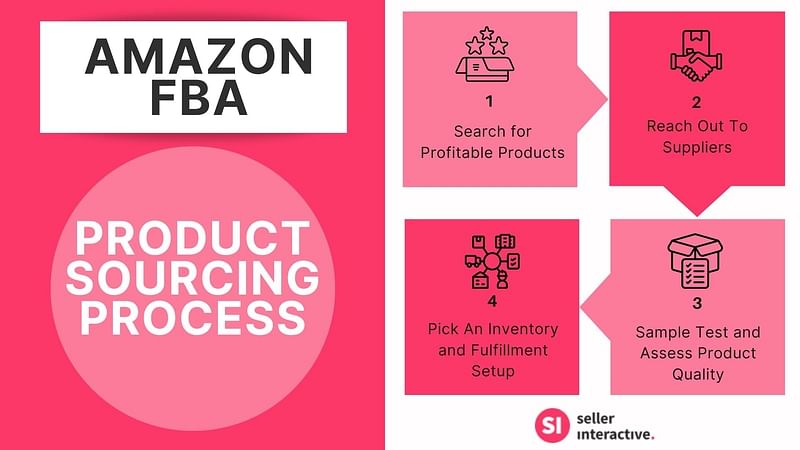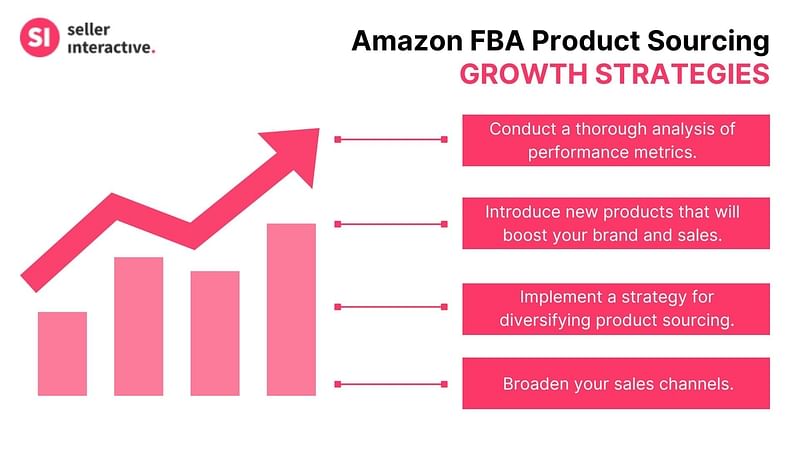
Last updated on November 9th, 2023
 Written by Mohamed Aden
Written by Mohamed Aden
Becoming a Fulfillment by Amazon (FBA) seller provides access to a global market. FBA takes care of many practical aspects of running a business such as warehousing, shipping, and customer service. If you want to succeed in this domain, one of the key skills you need to master is Amazon FBA product sourcing.
This article focuses on revealing practical strategies and helpful tips to facilitate your journey towards becoming an FBA product sourcing expert. You’ll learn valuable information on different types of product sourcing, factors to consider, the sourcing process, scaling strategies, and more. So, keep reading!
What is Amazon FBA Product Sourcing?
FBA product sourcing refers to finding and acquiring products to sell on Amazon. This involves researching, selecting, and purchasing products that have the potential for profitability and meeting customer demand on the platform.
Types of Product Sourcing Strategies
By determining the most suitable product sourcing strategy for your business goals, you can effectively manage inventory, maintain high product quality, and optimize your profit margins. Each of the sourcing methods below has its pros and cons. Thus, choosing the one that best aligns with your resources, expertise, and objectives is crucial.
Discounted Prices on Retail Arbitrage
Retail arbitrage involves purchasing products from stores like Walmart, Target, and other local stores at discounted prices and then selling them on Amazon at a higher price.
| Retail Arbitrage Pros |
|
|
| Retail Arbitrage Cons |
|
|
Online Arbitrage for Discounted Products
Take your product acquisition online for convenience through online arbitrage. It’s similar to retail arbitrage, without the hassle of going to physical stores. You can purchase and sell products from eBay, Etsy, or other discount websites.
| Online Arbitrage Pros |
|
|
| Online Arbitrage Cons |
|
|
Wholesale Sourcing
Through wholesale sourcing, you can purchase products in bulk directly from manufacturers or distributors. Suppliers usually provide quantity discounts for bulk purchases, which can lead to higher profit margins. To obtain the best possible rates for your inventory, research multiple suppliers and negotiate deals.
| Wholesale Sourcing Pros |
|
|
| Wholesale Sourcing Cons |
|
|
Private Labeling
Private labeling entails sourcing products from manufacturers and applying your brand name to the product, thus creating an exclusive product line with its identity under your control. Conduct thorough product research and be mindful of customer preferences and marketplace trends before starting your private label business.
| Private Labeling Pros |
|
|
| Private Labeling Cons |
|
|
Manufacturing and Customization
Manufacturing and customization involve creating unique, customized products by producing them yourself or partnering with a third-party supplier. This strategy grants maximum control over product specifications and quality management.
If you have a creative product idea with a high demand and low competition, manufacturing and customization can lead to a highly profitable Amazon FBA business.
| Manufacturing and Customization Pros |
|
|
| Manufacturing and Customization Cons |
|
|
Factors to Consider When Sourcing Products for FBA
Optimizing your FBA product sourcing strategy opens the door for long-term business success. Whether you’re expanding product sourcing or switching to a different one, use the factors below as a guide as you go through various sourcing strategies.
Product Criteria
When choosing products to sell on Amazon FBA, finding profitable items that cater to customer preferences and have a high demand is essential. You can perform product research by analyzing sales rank, marketplace trends, and monthly search volume.
Consider lightweight products, small in size, and easy to manufacture, as these attributes can help you achieve better shipping rates and lower production costs. You may also choose to specialize in a specific product niche or sell a variety of product categories.
Shipping Costs, Profit Margins, and Pricing
When sourcing products, it’s critical to factor in shipping costs and pricing strategies. Calculating profit margins involves considering all expenses, including inventory, shipping, advertising, and Amazon fees.
Set competitive pricing while maintaining high-profit margins. This requires monitoring price history charts, fluctuations, and optimization techniques. Always consider prospect analysis and the potential for high demand and medium competition.
Quality Control and Brand Reputation
To build a successful FBA business, maintain a high level of product quality, and develop a strong brand reputation. Choose reliable suppliers or manufacturers that can consistently deliver high-quality products.
Work with multiple suppliers to guarantee product availability. Consider developing your brand name and packaging to enhance customer perception and increase sales. Regularly review customer ratings and feedback, and use them as a guide to improve what you sell.
Legal and Regulatory Compliance
When sourcing products for FBA, it is essential to ensure legal and regulatory compliance. Here are some steps you can take to ensure just that:
- Verify that the items you sell adhere to Amazon’s seller guidelines and product restrictions.
- Consult legal and regulatory professionals to stay informed about laws and regulations surrounding your products and the market.
- Acquire necessary permits, certifications, and licenses.
- Adhere to safety, environmental, and import/export regulations and laws.
The FBA Product Sourcing Process
Product research, finding suppliers, and product quality control are just some of the steps you need to take for FBA product sourcing. Let’s check them one by one, so you can do them correctly.

Step 1: Search for Profitable Products
Conduct thorough market research. Start by analyzing Amazon’s marketplace trends and customer preferences to identify popular product categories and profitable products. Keep in mind the sales rank of products and competition from other sellers. Use price history charts to understand price fluctuations and predict prospect analysis.
Step 2: Reach Out To Suppliers
Once you have identified potential product niches, focus on finding reliable suppliers offering high-quality products at discounted prices. Study various sourcing methods mentioned above, and decide which works best for your Amazon business.
Reach out to potential suppliers, including dropshipping suppliers, manufacturers, liquidation stores, or even chain stores, and negotiate quantity discounts to ensure profitable inventory. Due diligence is essential to establish long-term relationships with trusted suppliers.
Step 3: Sample Test and Assess Product Quality
Before purchasing inventory from your selected supplier, request product samples and perform thorough quality assessments. Examine the products and ensure they are up to Amazon’s standard to avoid negative reviews and impact on your reputation as an Amazon seller.
Step 4: Pick An Inventory and Fulfillment Setup
Depending on your business model and goals, you can use a single or multiple suppliers to source your Amazon FBA products. This decision impacts aspects like managing inventory, shipping costs, and fulfilling customer orders.
Calculate shipping costs, Amazon FBA fees, and storage requirements for your sourced products to ensure your business model remains profitable.Regardless of the approach, stay on top of your inventory levels to avoid stockouts, which could lead to lost sales opportunities.
FBA Product Sourcing Growth Strategies
When you’ve mastered FBA product sourcing, scaling your business will be easier. You can use the strategies below to help not only in product sourcing but in ensuring your business grows.

Analyze Performance Metrics
To effectively scale your Amazon FBA business, it’s crucial to analyze the performance of your products. Track key metrics like sales rank, profit margins, and advertising costs to make informed decisions.
Consider aspects such as monthly search volume, customer preferences, and competition when sourcing products. By identifying profitable products with consistent demand, you’ll be better equipped to manage inventory, optimize pricing, and improve your overall ecommerce business strategy.
Launch New Products
Launching new products within your niche will strengthen your brand and cater to the evolving preferences of your target audience. To do the launch right, you can apply these strategies:
- Conduct product research.
- Identify product niches that complement your existing inventory and have high demand.
- Opt for items with medium competition and high-profit margins to differentiate from other sellers on the platform.
Diversify Product Sourcing Strategy
Use various sourcing methods like wholesale, private label, or online and retail arbitrage. Exploring multiple suppliers, such as dropshipping suppliers, surplus stores, or liquidation stores, can secure discounted prices, increasing your profit margins.
Expand Your Reach
Explore expanding your sales channels beyond Amazon. This could include launching your online stores or working with third-party suppliers. Diversifying your sales channels will help mitigate risks and enable you to tap into new markets, promoting growth and long-term stability for your business.
Challenges and Future Trends
To be well on your way to building a thriving Amazon FBA business, you must be well aware of the challenges and future trends below. The knowledge will help you prepare for roadblocks and maintain a thriving store.
Increasing Competition
Due to the success of many Amazon FBA sellers, competition is getting tougher. To stay ahead, here are some things you can do:
- Constantly refine your product sourcing strategies and adapt to the market’s changes.
- Choose profitable products with high demand and medium competition to maintain your chances of success.
- Remember the importance of managing inventory, maintaining profit margins, and monitoring advertising costs.
- Familiarize yourself with different price history charts and the metrics of various product categories to stay informed of the competitive marketplace.
Rising Consumer Expectations
As an Amazon seller, you must meet the rising expectations of consumers, who are increasingly focused on product quality, quick delivery times, and competitive pricing. To do so, here are the things to add to your action plans:
- Prioritize high-quality items with good profit margins.
- Partner with reliable suppliers.
- Explore quantity discounts.
- Consider sourcing from multiple suppliers to help reduce shipping costs and ensure product quality.
- Stay tuned to customer preferences, pay attention to monthly search volumes, and adapt your product listings accordingly.
- Regularly assess the product specifications, price optimization, and overall customer satisfaction to meet the expectations of your target audience.
Integration of AI and Technology
Integrating AI and technology has changed the landscape of FBA product sourcing. To stay relevant in the market, develop your knowledge and skills related to digital tools and automation. These apps and software can assist you in accomplishing the following:
- AI-driven product research, sourcing methods, and inventory management systems
- Monitoring marketplace trends, such as adjusting your product niche in response to customer demand and refining your inventory strategies
- Familiarizing yourself with various drop shipping, ecommerce integration, and advertising technologies to improve your sourcing process, expand your product line, and achieve your business goals
Partner With Seller Interactive
As an aspiring FBA seller, choosing the right product and sourcing strategy can make or break your business. To tackle the challenges in FBA product sourcing, it’s crucial to grasp key concepts and follow the best practices we shared.
Partnering with an experienced agency like us here at Seller Interactive can be a game-changer too. We are industry experts specializing in product launches for Amazon. We’ll guide you through every step of your product sourcing journey, from selecting the ideal niche to connecting with trusted suppliers and optimizing your listings for maximum visibility and sales.
Book a call with us now. Let us assist you in navigating the Amazon FBA landscape and turn your entrepreneurial vision into reality.
Discover more from reviewer4you.com
Subscribe to get the latest posts to your email.




